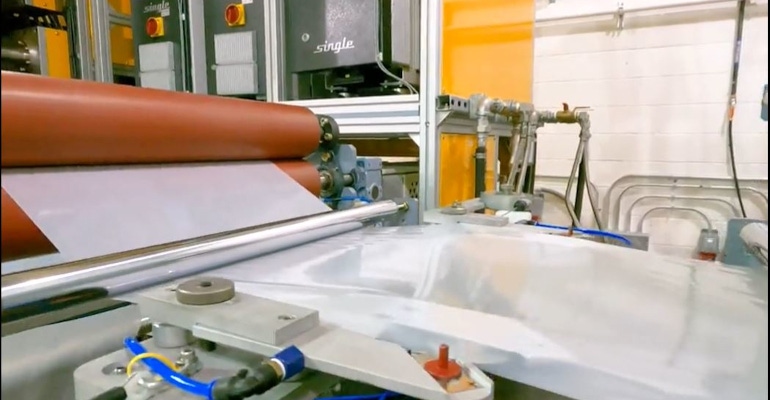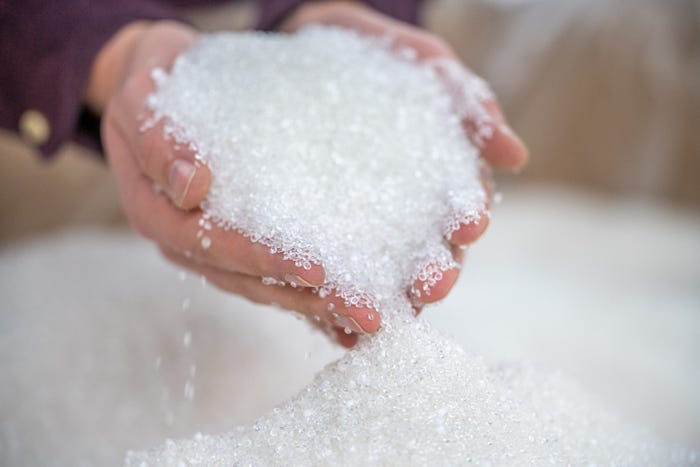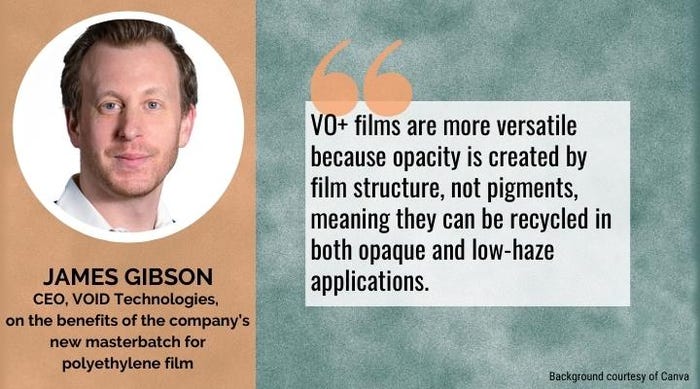Flexible Packaging That Uses 35% Less Plastic?
A new masterbatch adds air pockets to polyethylene films. The lighter-weight material actually performs better structurally and improves the potential for recycling.

Flexible packaging is already lightweight, especially compared to rigid containers. But product manufacturers continue to look for ways to reduce their use of plastic in packaging.
The new VO+ masterbatch from VOID Technologies offers another option to minimize your plastic footprint. VOID Technologies’ CEO James Gibson explains how this is possible in this Packaging Digest exclusive.
Give us a short explanation of what VO+ technology is all about.
Gibson: VO+ is about accelerating the transition to more sustainable plastics and flexible packaging. It’s an extensively patented cavitation/voiding technology that engineers nano- and micro-scale voids — air pockets — in plastics to reduce density and material use, enhance performance, and improve recyclability. VO+ is effective in thermoplastics including polyolefins and polyesters and in a range of product forms including film, sheet, fiber, and filament. And in case you were wondering, we named our company after the voided structure that VO+ creates in polymers.
Today, VO+ technology is most developed in Machine Direction Orientation (MDO) polyethylene (PE) film. By combining the benefits of MDO with VO+ technology, we address the conflict between material reduction, performance, and recyclability. In that sense, VO+ is a breakthrough that presents a unique proposition for packaging manufacturers and consumer goods companies. It reduces polymer density while improving mechanical properties like puncture and toughness, which in turn allows for films to be down gauged, which offers even more material reduction.
Additionally, when the VO+ voided structure is created, light is diffracted by the film creating high levels of opacity without the need for pigments like TiO2 (titanium dioxide). This is an important benefit because it means that VO+ films can be recycled with clear plastics waste streams without causing color contamination.
VO+ MDO PE films are relevant to a range of markets including flexible packaging, agriculture, and industrial goods.
How is the VO+ technology similar to — and/or different from — nanotechnology that adds clay to a film structure to improve barrier and reduce plastic usage?
Gibson: Nanoclays and VO+ are very different technologies. Typically, nanoclays are used to improve the thermal and barrier properties of plastic films.
In comparison, VO+ is a polymeric additive system supplied to film and packaging manufacturers as a masterbatch resin pellet. We would not generally describe VO+ as a “nano technology” based on the conventional usage of that term, but rather it’s a different technology that uses polymer inclusions to create nano- and micro-scale voided structures in plastics to reduce weight, enhance mechanical properties, and create opacity without TiO2. These combined benefits are enabling us to develop more sustainable products with improved recyclability.
It might also be tempting to compare VO+ to CaCO3, which can be used as a cavitation agent. CaCO3 is used today in polyolefins such as biaxially oriented polypropylene (BOPP) or PE breathable films in hygiene applications. However, our analysis shows that in linear low-density polyethylene (LLDPE) films VO+ is a much more efficient cavitation agent at equivalent loading levels, enabling much higher opacity and lower density. Furthermore, VO+ does not reduce the barrier performance of PE films, whereas CaCO3 is often used to deliberately make breathable films with high water-vapor transmission, making VO+ more suitable for applications such as food packaging.
What size are VO+ nano- and micro-voided “holes”?
Gibson: The size of the individual void ranges from 100’s of nanometers up to 10 micrometers.
What about using this technology for cross-direction oriented films or biaxially oriented materials? What percentage of packaging films are oriented in machine direction? Just trying to get a sense of the size of the potential market.
Gibson: VO+ is applicable to biaxially or cross-direction oriented films. Our primary focus has been on the MDO film market, which is rapidly growing. We see many new MDO assets being installed because the industry urgently needs to address the demand for plastics sustainability and decarbonization. Many multinational consumer packaged goods (CPG) companies have pledged publicly to reduce plastic. There are also new regulations and plastic taxes that are rapidly coming into force in Europe.
MDO is an excellent technology for downgauging films to use less plastic. It’s already being used to great effect in all-PE pouches (oriented polyester/OPET replacement). When VO+ is combined with MDO it offers a superior proposition based on creating high-performance products with an even lower environmental footprint.
This technology can be used on blown and cast films, correct?
Gibson: Correct, the technology can be used in blown and cast MDO films.
Does the film have to be monolayer? What about coextruded structures?
Gibson: VO+ can be added to either monolayer or coextruded film structures. We find that VO+ is very efficient when included in one or more layers of a coextruded film. This enables flexibility for downstream processing such as printing, sealing, and treatment.
How do you control uniform dispersion of the masterbatch during film production?
Gibson: Our proprietary VO+ masterbatch process creates a uniform additive dispersion when letdown during film extrusion.

What maximum percentage of plastic can be reduced? How does that compute into the amount of VO+ masterbatch added to the film manufacturing process?
Gibson: This depends on the polymer and requirements for the application. In MDO PE films, we typically achieve about a 35% material reduction based on 11% VO+ additive in the final film. Although, we have additive systems in development that could offer up to 50% material reduction.
Beyond material reduction, it’s worth highlighting that a number of our customers are also using VO+ to solve recycling challenges related to very high opacity film. These films often have a density over 1g/cm3 due to high loading levels of TiO2 and this creates a recycling challenge because the film can’t easily be separated during a sink/float recycling process. VO+ films can achieve very high opacity levels while maintaining a density below 0.90g/cm3.
What is the minimum and maximum gauge of film this technology can produce?
Gibson: In blown film, VO+ has been used in film gauges from 0.8 mil (20μm) to 2 mil (50μm). If a manufacturer uses collapsed bubble, then the maximum gauge can be doubled to 4 mil (100μm). In cast, VO+ film gauge can be increased to 40 mil (1mm) and above.
What about costs? How much is the masterbatch? What’s the return on investment?
Gibson: As is common with all raw material suppliers in our industry, we prefer not to publicly disclose pricing. We can say that VO+ offers a unique value proposition with a highly attractive ROI for the supply chain.
Who came up with this concept and how?
Gibson: VO+ technology was invented at Kimberly-Clark as part of a research initiative. At that time, VOID’s Chief Engineer, Ryan McEneany, was part of Kimberly-Clark’s sustainability team. He is one of the co-inventors of the VO+ technology. Later, in 2015, VOID was spun out and launched as an independent company to further develop and commercialize VO+.
How are these companies involved: Kimberly-Clark; Sabic Ventures; and Capricorn Partners?
Gibson: These companies are investors and shareholders in VOID. Beyond this, we are not in currently a position to discuss confidential projects.
How is it that this technology enhances performance capabilities like film toughness and puncture resistance even though it removes material?
Gibson: VO+ leverages mono and biax orientation technologies to enhance mechanical performance of polyolefins. When films are stretched, the polymer chains align, and this builds mechanical strength. Our tests show that VO+ films typically have equivalent or improved mechanical properties compared to a standard MDO film.
Explain how this technology facilitates recycling from a pigments point of view. I’m guessing this is still store-drop-off or industrial recycling, that is, reintroducing plant scrap into the manufacturing operation?
Gibson: VO+ films are more versatile because opacity is created by film structure, not pigments, meaning they can be recycled in both opaque and low-haze applications. Conversely, traditionally pigmented films are a contaminant in low-haze/transparent recycling streams, and so only have use in white and colored streams, limiting their recyclability. VO+ scrap can also be incorporated back into VO+ films.

A second important benefit is that VO+ films have high opacity levels with low density (below 0.90g/cm3). This means VO+ films can easily be separated during a sink/float recycling process, which is a limitation for some high-opacity films in the market today that have been heavily loaded with TiO2 such that their density approaches or exceeds 1g/cm3.
In terms of films and packaging made with VO+, manufacturers need to evaluate recyclability in the context of the final product. VO+ accounts for a small percentage of the film structure and final product. We expect VO+ to improve, not inhibit, recyclability.
Does this opaque feature mean that VO+ technology cannot be used when the desire is to have clear film packaging? Any way to control placement of the masterbatch to create a clear window maybe?
Gibson: This is a great question. Our technology is ideal for white films since the opacity is created by the structure. But we are working on some exciting new ways to create clear windows by applying heat, which collapses the voids. That’s under development now.
Tell us about the new R&D service at VOID’s facility. Why is this an important step in commercializing the technology?
Gibson: We recently completed a multimillion-dollar investment and opened our R&D labs in Neenah, Wisconsin. Our lab includes a range of extrusion equipment, including pilot-scale blown film extrusion with inline MDO, lab- and commercial-scale twin screw compounding, as well as a range of testing and analytical equipment. This start-of-the-art capability is enabling us to accelerate our R&D and product development programs.
In addition, we recently launched an R&D Services business through which plastics, packaging, and CPG companies can access VOID’s new equipment. This means that companies can rapidly conduct pilot scale trials to evaluate VO+ technology and their own innovation.
You’re targeting laminates, wicketed bags, and frozen food applications, correct? Why these applications? What other markets and/or packaging applications are suitable for using this technology
Gibson: We made the choice to focus on these large-volume applications based on three criteria: the demand for sustainable solutions driven by consumers and legislation, technical fit, and access to the value chain. We also have several large category applications in development such as flow wrappers, industrial packaging, and agricultural films.
You already have projects in the works, with a commercial launch later this year, right? What more can you tell us about that?
Gibson: VOID is working with a number of leading film and packaging manufacturers and consumer goods companies primarily in North America and Europe. We are on course to launch consumer packaging products with them later this year. Because of confidentiality agreements, I can’t say exactly which customers we are working with but, for example, they include major suppliers and brands in the food, personal, and home care sectors.
About the Author(s)
You May Also Like




